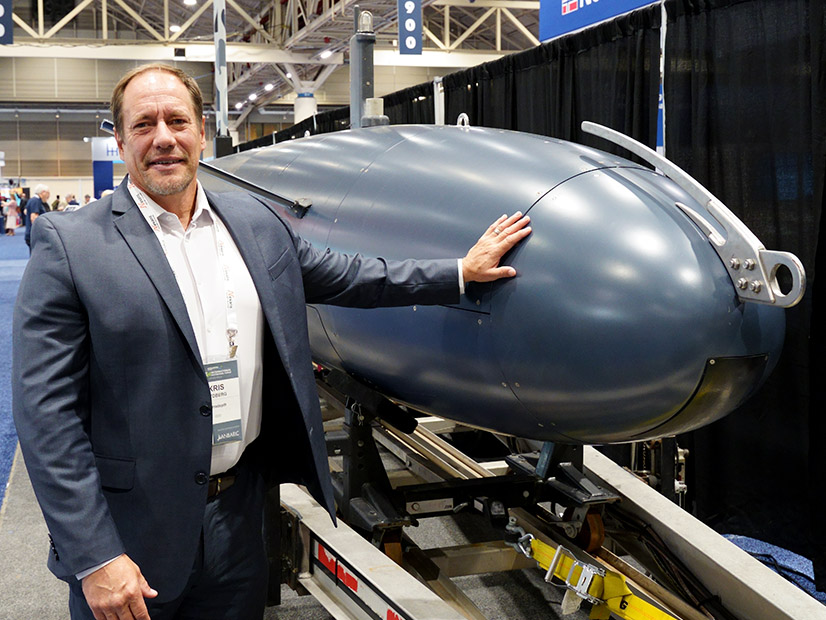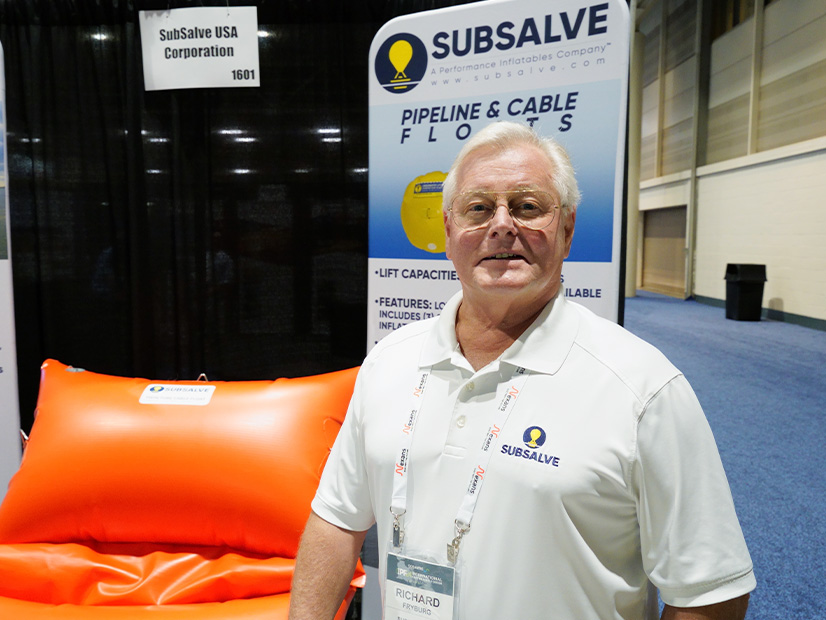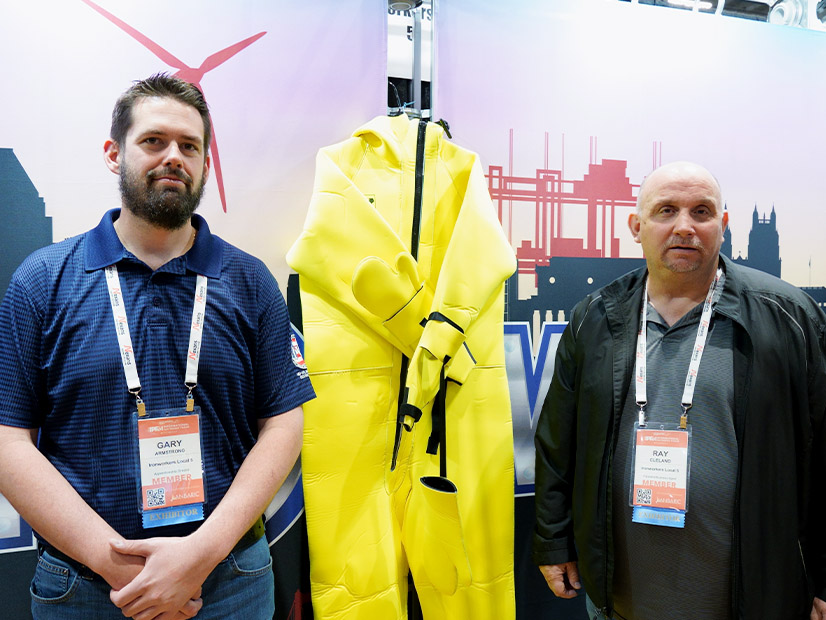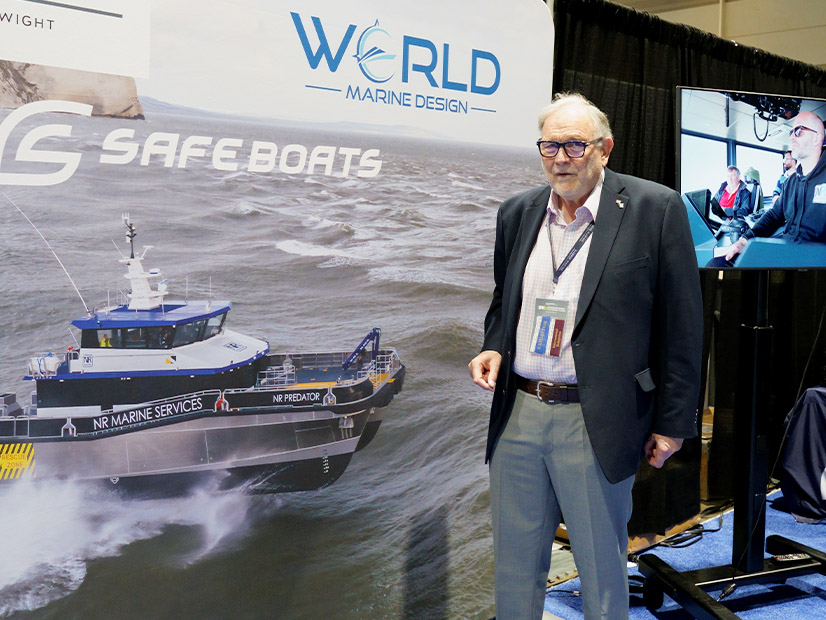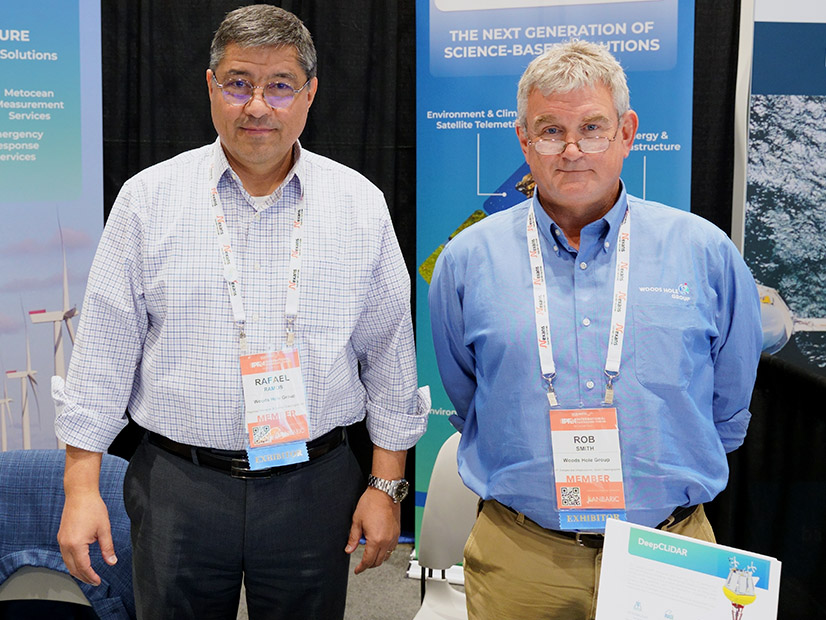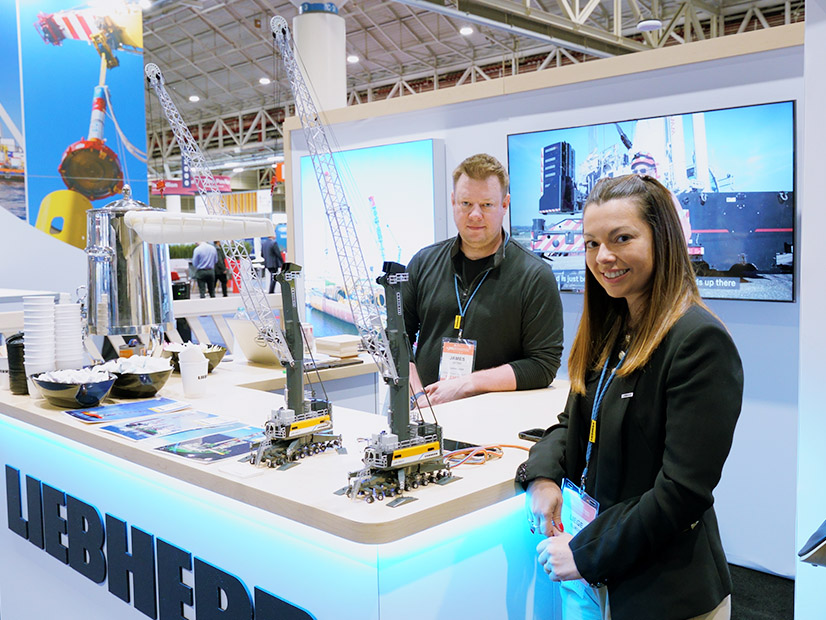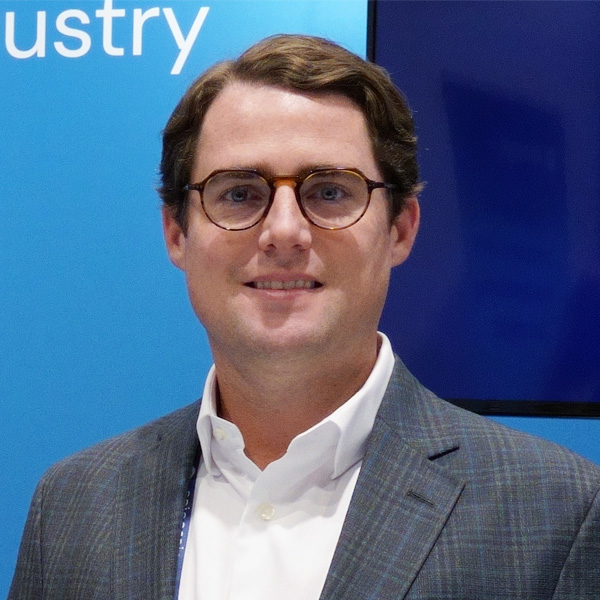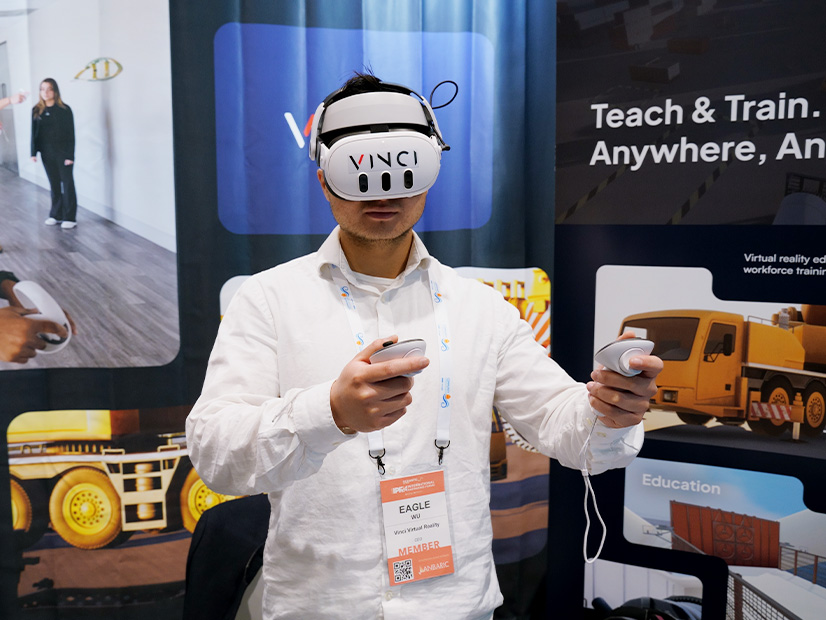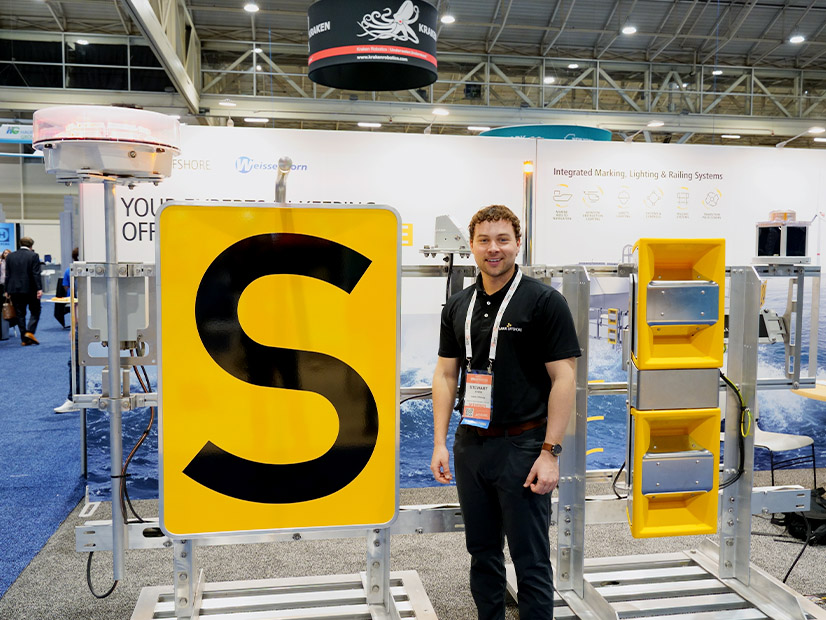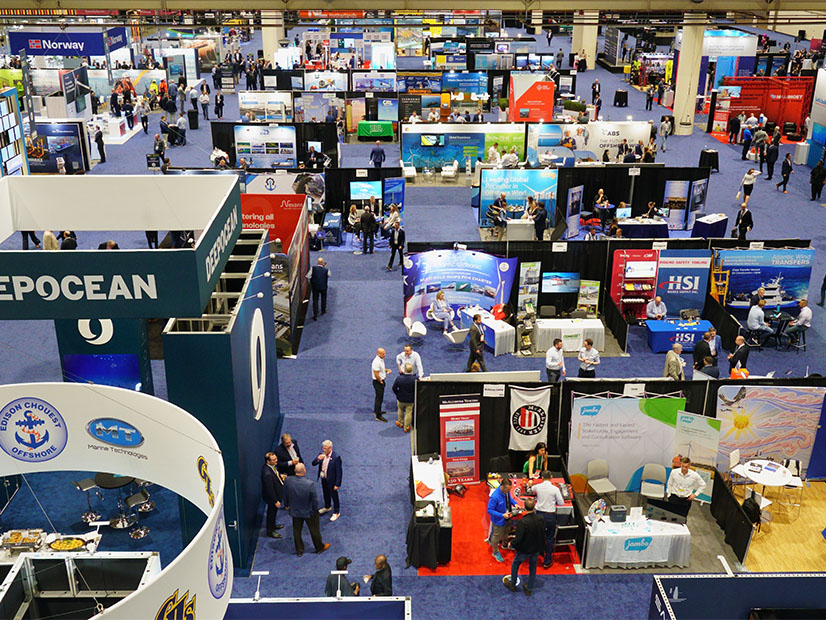
NEW ORLEANS — Offshore wind is touted as a source not just of emissions-free electricity but also economic stimulus, giving many businesses at every level of the food chain a stake in each multibillion-dollar wind farm.
More than 375 exhibitors were on hand at the International Partnering Forum April 22-25, hoping to steer some of that money to their companies.
In dozens of booths across acres of floor space, they pitched everything from bird warning systems to construction vessels to training. Exhibitors ranged from startups to industry leaders, labor unions to national trade delegations.
On the last day of IPF24, NetZero Insider spoke with a random assortment of exhibitors about their impressions of the U.S. offshore wind market, their take on the convention and the products they were pitching. Here’s what they had to say.
Underwater Autonomy
A sleek machine on a three-axle trailer that looked like a cross between a torpedo and a submarine was neither — it was “Abraham,” Terradepth’s prototype autonomous underwater vehicle.
It is built to operate for up to a thousand nautical miles on its own, conducting underwater surveys for up to a month at a time and resurfacing as needed so its diesel generator can draw air and recharge the lithium-ion batteries that power it underwater.
It holds the potential of massive savings in fuel and personnel costs compared with survey operations controlled from a crewed surface vessel.
Terradepth is trying to bring Abraham to the attention of offshore wind and other marine industries, said Chief Operating Officer Kris Rydberg. It needs decision-makers to open their minds about a new way to approach underwater tasks and open their wallets to make that happen.
“This is not inexpensive and we’re a startup,” he said. “We bootstrapped it up to this point. We’re going to need some additional funding to go from prototyping to full-on commercial. But the concept, the technology is proven.”
Buoyancy Manufacturer
Richard Fryburg, chief growth officer of Subsalve, said he is eager for American manufacturers such as his company to reap the benefits of the wind projects proposed off our shorelines.
With his broad New England accent and his stack of blazing fluorescent buoyancy sacks, Fryburg and his booth were hard to miss. But visibility was not translating to sales.
“We’ve been approached to provide our products by many of these companies coming in from outside the U.S., who have proposed that they want to buy locally,” he said. “They’re not buying locally. They’re bringing products, staff and equipment from outside of the country. And there’s a gap, and I’m not sure how that gets fixed, but I don’t see that local vendors and suppliers are benefiting that greatly from this insurgence of foreign companies.”
Fryburg added: “I think we’re competitive on price.”
Union Ironworkers
Ironworkers Local 5 had one of the more visually striking displays in the exhibit hall and easily the most ironic swag: The same guys who assemble tons of structural steel were handing out balsa-wood toy gliders weighing a few grams apiece.
The thousand-member local hopes its members will gain from the spate of construction planned off the East Coast, said Ray Cleland.
What the union would like, as early as possible, is a list of certifications that managers want ironworkers to bring to a given project, Gary Armstrong said. Local 5 can draw workers from any local in the country and it can do training — if it knows the skillsets needed.
“Sparrows Point (Maryland) was contracted for some secondary steel components, and we had like 45 ironworkers there working,” Armstrong said. “Then Ocean [Wind] 1 stopped, and we lost that contract.”
But things are looking up onshore.
“I think there’s always going to be work,” Armstrong said. “With the big infrastructure money starting to roll out, there’s going to be a lot of other opportunities, too.”
Boatbuilder
Simon Thomson, international business development director for English boatbuilder Diverse Marine, had a glum assessment of the U.S. market for his company’s crew transfer vessels:
“Flat and dead.”
He partly blames politics. There is one permitting system in the United Kingdom and hundreds in the United States, often with significant variations from one state to the next.
Thomson said things take longer to get built in America, too. He pointed to a mural-sized photo of the newest Diverse crew transfer vessel, the Predator, speeding away for delivery to the customer.
“The length of time to build a boat like that — that was delivered two weeks ago — is about a third of the time it’s taking here [in the U.S.],” he said. “If you said to me today, I want to build four of those, just like that, you could probably start cutting metal within — let’s go for it — 10 days.”
The issue is moot, in a sense. Because of the Jones Act, Diverse cannot sell the vessels it builds on the Isle of Wight for use on U.S. offshore wind projects. So, it has a manufacturing partner in Washington state.
Does Thomson see a growth pattern for U.S. offshore wind?
“That’s a very difficult question to answer, because of all the issues you have and all the political decisions,” he said. “We look at the United States as separate countries all held together in a union. You all have different rules, laws and interests.”
Ocean Researcher
Woods Hole Group is the commercial oceanography spinoff of the oceanography research institute of the same name in Massachusetts.
The data and data analysis the company provides is valuable for every stage of a wind farm’s existence, from planning and design to operation to decommissioning.
Woods Hole Group started this work in oil and gas, senior manager Rafael Ramos said, and it was a natural transition to wind. The company sees a good future in this sector.
“In the U.S., it got off to a flying start, and then we hit this barrier with projects being canceled,” Energy and Mining Business Unit Director Rob Smith said. “I think it’s a hiatus, I think it’s a rebalancing.”
“We’ll get there,” Ramos said.
Cranemaker
James Jatho and Liège Olmos were on hand to represent Liebherr, a German crane manufacturer.
Jathos said IPF24 was a mixed bag from his perspective, because the company’s push at the show was its maritime products — the cranes mounted on ships and offshore platforms.
“I handle mobile crawler cranes,” he said. “So, we’re pursuing offshore wind in the sense that you need something to move stuff around on the ports. For me, the show wasn’t as successful for direct customers who would buy from us, but more so talking to engineering firms, the various ports, getting our product out in front of them so that when they do need a crane, they come to Liebherr first.”
Olmos said they attended IPF23 in Baltimore last year. “We had a small booth there, but the quality of leads we got there was surprisingly good, so we decided to go bigger this year. This year, I think the convention center is too big. We got less traffic, but the quality of the leads are good.”
Liebherr does have an answer for the heaviest offshore wind components, Jathos said: the L-13000, rated at 3,000 tons. The seven that have been built are the largest crawler cranes outside of China. The eighth is being built now, and the wait time for the ninth will be in the 18- to 24-month range.
Performance Maximizer
At its booth, Spinergie was promoting its suite of fleet efficiency services.
During planning, construction and operation of an offshore wind farm, “there’s a lot to coordinate, there’s a lot of vessels that are orchestrating the project all at the same time,” said Patrick Sanguily, general manager Americas.
“We recently supported a survey campaign off the East Coast. I can’t say for whom. We tracked all the service vessels, facilitated the daily reporting from the vessel to the charterer, we gave them the metrics dashboards so they could monitor the survey.”
This type of data is valuable for cost control.
His take on IPF24 and the industry in general?
“The enthusiasm is consistent,” Sanguily said. “Of course there was some recent news, some reshuffling of the schedule. But the goals remain the same. There’s some moving targets out there but it seems the industry will continue to push forward.”
Virtual Career Awareness
Vinci Virtual Reality CEO Eagle Wu was demonstrating his company’s virtual-reality workforce development tools.
Their primary intended use is early career familiarity and training, Wu said, giving prospective workers some sense of what it’s like to work in a situation or setting that they cannot see firsthand.
“These projects in the U.S. are coming four or five years from now, which has its challenges,” he said. “But what many people now recognize is, if you want to have workers to hire in four or five years, you need to talk to students today. There’s a lead time.”
A simulated experience of working on a wind turbine or the associated support functions can recruit youngsters to the field, he said.
Safety Equipment Maker
Sabik Offshore has been coming to IPF for a decade, ever since it was a small event in a hotel. The safety equipment manufacturer appreciates the conference because it has fostered the formation of a community, said North America regional sales manager Stewart Erwin.
Sabik works only in offshore wind. Not oil rigs, not ferry boats, just offshore wind. The company’s products, including fog warnings and railings, are in place on the early projects off the Northeast U.S. coast.
Sabik has a steady business elsewhere in the world, Erwin said, and expects the U.S. market to grow as well.
Additional IPF24 Coverage
Read NetZero Insider’s full coverage of the 2024 International Partnering Forum here:
Central Atlantic Region Prepares for OSW Development
How Best to Address OSW’s Effects on Fisheries
Interior Announces Updated OSW Regs, Auction Schedule at IPF24
Louisiana Manufacturers Expand into Offshore Wind
Moving Offshore Wind Beyond Contract Cancellations
